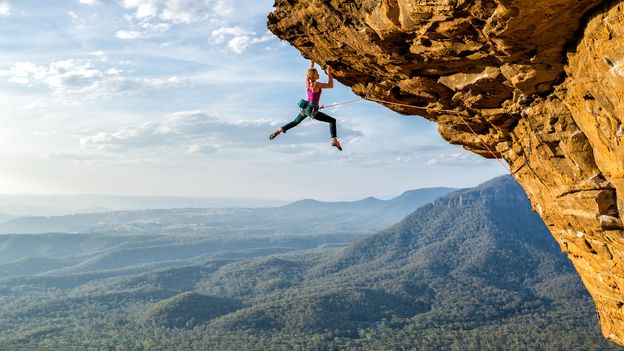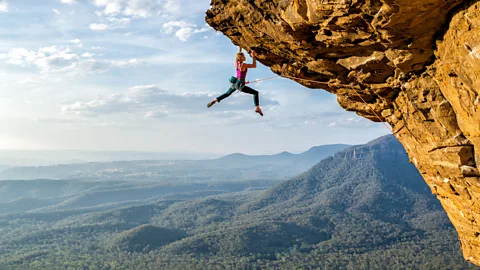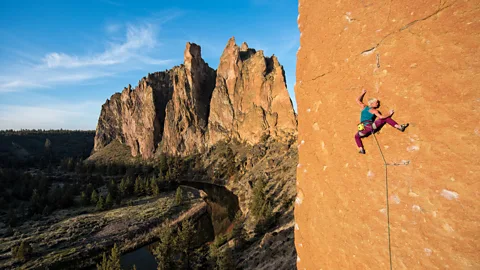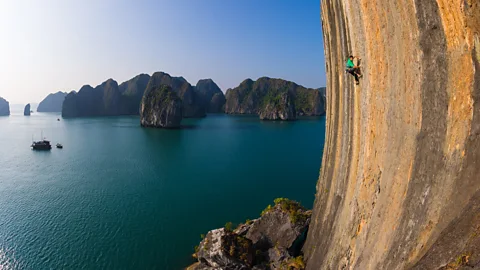World
Five of the world’s most beautiful climbing locations

 Simon Carter
Simon CarterFrom Tasmania to Vietnam, the world is filled with astounding rock formations for intrepid climbers. Here, Australian climber and photographer Simon Carter picks five of the best.
Maybe it was Tom Cruise clambering up the red rock of Utah’s Dead Horse Point in Mission: Impossible II that made people want to test their mettle, or the Oscar-winning film Free Solo that documented Alex Honnold’s inspirational ascent of the 3,000ft-high rock face of El Capitan in Yosemite National Park without ropes or safety gear. Whatever the reason, climbing has boomed in popularity around the world.
“I’ve seen so many people getting into outdoor climbing over the last 20 years,” says Australian climber and photographer Simon Carter. “A lot of that’s down to films, and to the proliferation of indoor climbing gyms, as well as sport climbing finally making it into the Olympics in 2020 in Japan.”

MEET THE EXPERT
(Image credit: Coco Carter)
Australian rock climber and photographer Simon Carter established Onsight Photography in 1994. Since then, he has travelled widely and built an extensive body of work capturing many of the world’s best climbing destinations. Carter is the recipient of several photography accolades and the author of four previous coffee-table books, including Images from the Edge (2005), which won the Mountain Image award at the Banff Mountain Book Festival.
From Madagascar to China, the world is filled with towers, cliffs, caves and other astounding formations for intrepid souls who want to see what they’re made of, whether they’re sport climbing, bouldering, top-roping or free soloing. Many of the greatest climbing locations are gathered in Carter’s new book The Art of Climbing. “The physical and mental challenge of climbing” was what first attracted Carter, who’s been climbing for 40 years. “But as I got more into it, it was about the places I was exploring and the people I was hanging out with. What I love about climbing is you get to experience random places on the planet, which are so interesting – it gives you a slice of a place you’d rarely explore as a tourist. The connection to nature is one of the most powerful things. You spend long periods of time in the most spectacular locations. You end up awed and fascinated by these places.”
Here are five of Carter’s favourite climbing locations around the world to push your limits or just enjoy the sheer beauty of wild, rugged nature.
 Simon Carter
Simon CarterThe Tasman Peninsula pillars, Australia
For an edge-of-the-world feel, few places can match the Tasman Peninsula in south-east Tasmania, Australia. The peninsula’s known for Port Arthur, a famous convict colony from the 1800s when Australia was first settled by Europeans. But for climbers, it’s the rugged coastline’s giant sea columns of Jurassic dolerite, protruding up to 300m from the sea, that call to them.
About an hour’s drive from Hobart, Tasmania’s capital, the Tasman Peninsula is home to a famous “trilogy” of iconic pillars. “The Totem Pole, The Moai and Pole Dancer [pictured above] are adventurous outings for experienced climbers only,” explains Carter. “They all require at least two hours of hiking and an abseil to get to the pillars. The Moai (22m) is a moderately adventurous outing. In the case of Pole Dancer, it is a full-on adventure that takes at least five hours of hiking, two abseils and several pitches of climbing just to reach the start of Pole Dancer (40m) itself.
The Totem Pole, 65m metres high in total and only about 4m wide at the base, is quite a technically challenging rock climb for harder rock climbers. “It’s like a big matchstick – an incredible thing jutting out of the ocean. This is technical climbing in the most mind-blowing location you can imagine.”
Tasmania can be reached with direct flights from Melbourne, Sydney and Brisbane to Hobart and Launceston, or by the Spirit of Tasmania car ferry, which crosses between Geelong on mainland Australia to Devonport – having your own vehicle makes it easier to reach the island’s remote parts.
 Simon Carter
Simon CarterKalymnos and Telendos, Greece
Crete, Corfu, Santorini, Mykonos… some of the names of the 6,000 Greek Islands are incredibly well-known to holidaymakers. Kalymnos, between the islands of Kos and Leros in the Dodecanese chain, is far less famous, but among climbers, it’s legendary. “Kalymnos could not be more famous amongst climbers,” Carter says. “It’s a rocky island and it’s not aesthetically the most beautiful Greek island. But for climbers it’s a paradise, with cliffs and crags and caves all over it. It’s probably the most popular single rock-climbing destination in the world right now. There must be well over 4,000 individual climbs on the limestone crags scattered all over Kalymnos and the neighbouring Telendos Island. The range of difficulty covers every grade, from easiest climbs to incredibly difficult – there really is something for everyone.”
“EQUAL OPPORTUNITY”
“Climbing’s one of those sports that doesn’t discriminate against sex,” he says. “It’s about power, agility, finesse and the mental side. The percentage of female climbers is ever growing – it’s probably around 50% now. You can feel it: women climbers are on the rise.”
Travellers can take a direct flight from Athens to Kalymnos or catch ferries from other islands, such as Rhodes. Among the most remarkable and challenging climbing experiences is Crystal Cave (pictured above) on Telendos, reachable via a 30-minute ferry or water taxi from Kalymnos and then a 1.5km hike (or ask the boat to drop you closer to Crystal Cave, which they’re often happy to do). “Crystal Cave is a long, hard, technical endurance climb – a very physical, gymnastic route,” Carter adds. “You need a 100m rope to do it because the cave is so high; when you get to the top of the cave, you need enough rope to lower off and get back to the ground. It’s an extraordinary place.”
 Simon Carter
Simon CarterSmith Rocks State Park, US
“The steep clean walls had no cracks or features, so climbers started equipping the routes with permanently fixed safety bolts, which enabled climbers to concentrate on pushing the physical, gymnastic side of climbing, which became known as ‘sport climbing’ and took off around the country,” he says.
Reached via a 200-mile drive from Portland, the state capital, Smith Rock State Park is located in central Oregon’s high desert. “Smith Rocks is an awe-inspiring place,” says Carter. “The state park has the Crooked River running through it. It’s a little oasis in the middle of the countryside. You have ranches and farmland, and then, boom, this state park pops up out of nowhere with these cool orange welded tuff rock formations for climbing, including The Smith Rock Group (in the background of the photo above), The Christian Brothers, The Dihedrals, Aggro Gully and the Monkey Face. The area has a Wild West feel to me. It’s a place where you really feel you should be getting around on a horse. It has a slightly desolate feel, with these confronting walls of blankness.”
More that 2,000 routes line the park’s rocky landscapes. Most visitors go for one of the many easy or moderate routes, but hardcore climbers might attempt time-tested classics, such as To Bolt Or Not To Be, which is “a stunning, blank-looking 41m-high wall in the Dihedrals area”, according to Carter. “It requires consistent, hard climbing. When it was first climbed by French climber Jean Baptiste Tribout in 1986, it was the hardest route in North America. The cheeky name he gave the route made a point – soon after, sport climbing took off in the US. Years later, the route remains a coveted test-piece for top climbers today.”
 Simon Carter
Simon CarterLes Calanques, France
There’s a whole lot of limestone with abundant climbing opportunities along France’s south coast, but Calanques National Park, outside Marseilles, is the epicentre that draws in adventurers from around the world. “The Calanques is a very historically significant area for rock climbers. French mountaineers in the early 1900s would go there when the weather was bad in the mountains to hone their technical skills, so there are amazing traditional rock climbs, like Arête de Marseille, a classic, easy route for experienced climbers on La Grande Candelle formation overlooking the Mediterranean, which was first climbed in 1927, as well as more modern climbing.”
There are 26 calanques (or, roughly, “rocky inlets”) in the national park, a 520-sq-km area that’s popular with hikers, boaters, yachters, swimmers and nature lovers, as well as climbers. Marseille makes a good base, a 30-minute bus or car journey from the national park, or climbers can stay in one of the little port towns, such as Les Goudes. “Climbers can choose from some of the long, old traditional climbs, or hard modern sport climbs on overhangs and caves,” says Carter. “The climbing is easy-to-moderate, with some harder stuff. There’s something for everyone. The limestone here is so beautiful. Some of the climbs start from little beaches. What’s also special about the Calanques is that you’re climbing above the lovely sparkling Mediterranean ocean.”
 Simon Carter
Simon CarterHạ Long Bay, Vietnam
There’s a sedate pace to the junk boat cruises that carry travellers around Hạ Long Bay, a gorgeous area in north-east Vietnam with more than 2,000 limestone karsts soaring out of the ocean, some as high as 400m. But the Unesco World Heritage Site is also an adventure playground, with fantastic opportunities for sea kayaking, scuba diving, hiking and rock climbing. “Hạ Long Bay is a crazily beautiful place,” says Carter. “When you cruise around the area, you’re transfixed by what you’re seeing. It’s one of those places where you feel you’ve really travelled somewhere unique and adventurous.”
Cát Bà, the largest island in the bay, is the main hub for climbers, with the rugged mountains of Cát Bà National Park and the popular cliff Butterfly Wall. But to really experience the best of the Bay, you need to explore by boat. “Although many of the karsts are too sharp, low-angled and vegetated to be of interest to most modern rock climbers, there are specks of gold for adventurous explorers,” says Carter. “You could get lost in this area, exploring for days by boat.”
The Bay’s climbs are not ideal for novices. “You can’t get a lot done as a beginner there – it’s for adventurous, experienced climbers,” Carter says. He picks out The Face and Turtle Cave as two favourite climbs within easy reach of Cát Bà. “The Face is a huge wall of limestone, which looks like candlewax has dripped down the rock face. To climb it is an unusual experience. There are also plenty of climbs in the area where, once you’ve finished, you can abseil back down to a beach. But the greatest benefit of the area comes with the ‘deep-water soloing’ challenges, where you can just step off the boat and climb without a rope – just you, the rock and the ocean as your ‘crash pad’.” Turtle Cave is a perfect example of that, where climbers aim to climb to the lip of a cave 10m above the ocean – without using a rope.











